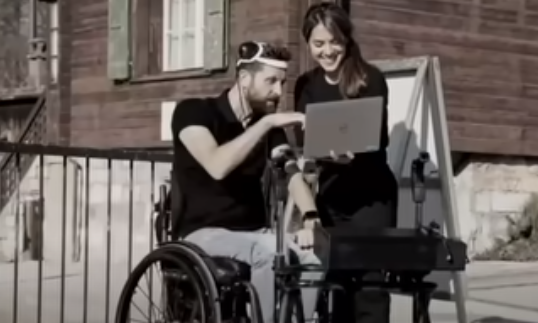Revolutionary Medical Device Enables Paralyzed Man to Walk Again after a Decade
In a groundbreaking discovery, recent research has unveiled the remarkable story of how a medical device has successfully restored natural walking abilities to an individual with paralysis, more than ten years after a severe injury. Dr. Grégoire Courtine and his team at the Swiss Federal Institute of Technology in Lausanne have developed and implemented a cutting-edge “brain-spine interface” that establishes a direct neurological connection between the brain and the spinal cord. By utilizing brain implants to monitor movement intentions, which are then wirelessly transmitted to an external processing unit worn by the person, this innovative technology has surpassed previous limitations in enabling smoother movements and better adaptability to varying terrains. The interface bridges the communication gap between two disrupted regions of the central nervous system caused by spinal cord injuries, providing renewed hope for individuals with paralysis.
Gert-Jan Oskam, a courageous 40-year-old who had been paralyzed following a motorbike accident in China over a decade ago, has become a testament to the immense potential of this medical breakthrough. Oskam’s injury had profoundly affected not only his legs but also his arms and trunk, leaving him with limited mobility. Speaking at a recent press briefing, he expressed his long-standing desire to regain the ability to walk. Oskam had previously attempted various methods to achieve this goal but found success elusive until he was introduced to the brain-spine interface.
With the new device, Oskam can now walk distances of at least 100 meters (approximately 330 feet), depending on the day, and stand unassisted for a few minutes. He finds these abilities invaluable in his daily life, recounting a recent experience where he needed to paint but lacked assistance. Thanks to the device, he was able to stand and paint by himself. Unlike previous stimulation devices, which required a deliberate movement to trigger the stimulation, the brain-spine interface allows Oskam to move freely and have the stimulation automatically activate when he decides to take a step.
Oskam’s inspiring journey showcases the immense potential of the brain-spine interface technology. By reestablishing crucial connections within the central nervous system, this innovative approach not only grants paralyzed individuals the ability to walk again but also offers them a sense of normalcy and independence in their lives. As further advancements are made in this field, the future holds promise for countless individuals seeking to reclaim their mobility and rediscover the joy of natural movement.
Medical Breakthrough Enables Paralyzed Man to Regain Full Control Over His Movements
Dr. Grégoire Courtine and his team have achieved a significant milestone in their research by developing a stimulation method that provides unprecedented control over movement for paralyzed individuals. In the case of Gert-Jan Oskam, the first participant in the trial, this stimulation has granted him remarkable abilities. According to Courtine, Oskam now has “full control over the parameter of stimulation, which means that he can stop, he can walk, he can climb up staircases.”
Following the surgical implantation of the devices, the establishment of neurological communication channels was swift. In fact, Oskam was able to take steps within a day of training. Astonishingly, this connection has remained reliable for over a year, even during Oskam’s time at home. The ability to walk independently with the aid of this “digital bridge” has also contributed to his regaining enough strength to take some steps even when the stimulation is turned off.
While Oskam’s case marks a significant breakthrough, the researchers are hopeful about the future possibilities of this technology. The success of this research validates the potential for re-establishing a neurological link between the brain and spinal cord, and it occurs rapidly. Expanding the scope of this connection could offer assistance to individuals with arm and hand paralysis or those who have experienced a stroke. However, the researchers aim to reduce the size of the system to enhance its portability.
“The concept of a digital bridge between the brain and spinal cord heralds a new era in the treatment of motor deficits caused by neurological disorders,” noted the researchers, emphasizing the transformative nature of their findings.
